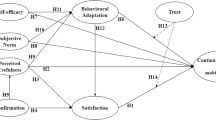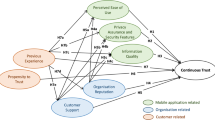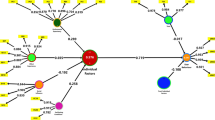Abstract
Drawing upon the technology acceptance model and trust theory, the present study develops a model to examine the effects of antecedent variables in customers’ continuance intention to use mobile banking service channels. Utilizing data from 202 respondents, an integrated approach of PLS-SEM analysis and mediation analysis using Hayes’ PROCESS macro in SPSS was employed to test the proposed model. Results revealed that the two constructs perceived ease of use and perceived usefulness from the technology acceptance model (TAM) in conjunction explained 68.9% of the variance in attitude. Results also revealed that attitude and trust were found to jointly explain 50% of variance in continuance intention to use mobile banking. Moreover, 53.2% of the variation in trust was jointly explained by structural assurances and bank’s reputation. The mediation analysis from Hayes’ PROCESS macro indicated that attitude and trust mediate the relationship between continuance intention and the respective antecedent variables.


Similar content being viewed by others
Notes
Shaikh and Karjaluoto (2015:131) defined mobile banking as “a product or service offered by a bank or a microfinance institution for conducting financial and non-financial transactions using mobile devices”.
References
Adams, D. A., Nelson, R. R., & Todd, P. A. (1992). Perceived usefulness, ease of use, and usage of information technology: a replication. MIS Quarterly,1, 227–247.
Agarwal, R., & Prasad, J. (1999). Are individual differences germane to the acceptance of new information technologies? Decision Sciences,30(2), 361–391.
Ajzen, I. (1985). From intentions to actions: a theory of planned behavior. In: Action control (pp. 11–39). Berlin: Springer.
Ajzen, I., & Madden, T. J. (1986). Prediction of goal-directed behavior: Attitudes, intentions, and perceived behavioral control. Journal of experimental social psychology, 22(5), 453–474.
Al-Jabri, I. M., & Sohail, M. S. (2012). Mobile banking adoption: application of diffusion of innovation theory. Journal of Electronic Commerce Research,13(4), 379–391.
Alalwan, A. A., Dwivedi, Y. K., & Rana, N. P. (2017). Factors influencing adoption of mobile banking by Jordanian bank customers: extending UTAUT2 with trust. International Journal of Information Management,37(3), 99–110.
Albashrawi, M., & Motiwalla, L. (2019). Privacy and personalization in continued usage intention of mobile banking: an integrative perspective. Information Systems Frontiers,21(5), 1031–1043.
Aldás-Manzano, J., Ruiz-Mafé, C., & Sanz-Blas, S. (2009). Exploring individual personality factors as drivers of M-shopping acceptance. Industrial Management & Data Systems,109(6), 739–757.
Alhabash S, Jiang M, Brooks B, Rifon NJ, LaRose R & Cotten SR. (2015). Online banking for the ages: Generational differences in institutional and system trust Communication and Information Technologies Annual (pp. 145–171): Emerald Group Publishing Limited.
Andreassen, C. S., Torsheim, T., & Pallesen, S. (2014). Predictors of use of social network sites at work-a specific type of cyberloafing. Journal of Computer-Mediated Communication,19(4), 906–921.
Bagozzi, R. P., & Yi, Y. (1988). On the evaluation of structural equation models. Journal of the Academy of Marketing Science,16(1), 74–94.
Barnett, M. L., Jermier, J. M., & Lafferty, B. A. (2006). Corporate reputation: the definitional landscape. Corporate Reputation Review,9(1), 26–38.
Bélanger, F., & Carter, L. (2008). Trust and risk in e-government adoption. The Journal of Strategic Information Systems,17(2), 165–176.
Bosnjak, M., Obermeier, D., & Tuten, T. L. (2006). Predicting and explaining the propensity to bid in online auctions: a comparison of two action-theoretical models. Journal of Consumer Behaviour: An International Research Review,5(2), 102–116.
Byrne, B. M. (2013). Structural equation modeling with EQS: basic concepts, applications, and programming. London: Routledge.
Cao, X., Yu, L., Liu, Z., Gong, M., & Adeel, L. (2018). Understanding mobile payment users’ continuance intention: a trust transfer perspective. Internet Research,28(2), 456–476.
Castelfranchi, C., & Falcone, R. (2010). Trust theory: a socio-cognitive and computational model (Vol. 18). New York: Wiley.
Cater, B. (2008). The importance of social bonds for communication and trust in marketing relationships in professional services. Management: Journal of Contemporary Management Issues,13(1), 1–15.
Chattopadhyay, P., George, E., & Shulman, A. D. (2008). The asymmetrical influence of sex dissimilarity in distributive vs. colocated work groups. Organization Science,19(4), 581–593.
Chau, P. Y. K. (1996). An empirical assessment of a modified technology acceptance model. Journal of Management Information Systems,13(2), 185–204.
Chau, P. Y. K. (1996). An empirical investigation on factors affecting the acceptance of CASE by systems developers. Information and Management,30(6), 269–280.
Chen, S. C., & Dhillon, G. S. (2003). Interpreting dimensions of consumer trust in e-commerce. Information Technology and Management,4(2–3), 303–318.
Chin, W. W. (2010). How to write up and report PLS analyses. In: Handbook of partial least squares (pp. 655–690). Berlin: Springer.
Cudjoe, A. G., Anim, P. A., Nyanyofio, J. G., & Tetteh, N. (2015). Determinants of mobile banking adoption in the Ghanaian banking industry: a case of access bank Ghana limited. Journal of Computer and Communications,3(02), 1.
Davis, F. (1986). A technology acceptance model for empirically testing new end-user information systems: theory and results. Cambridge, MA: doctoral dissertation, Sloan School of Management, Massachusetts Institute of Technology.
Davis, F. D. (1989). Perceived usefulness, perceived ease of use, and user acceptance of information technology. MIS Quarterly,1, 319–340.
Davis, F. D., Bagozzi, R. P., & Warshaw, P. R. (1989). User acceptance of computer technology: a comparison of two theoretical models. Management Science,35(8), 982–1003.
Dimitriadis, S., Kouremenos, A., & Kyrezis, N. (2011). Trust-based segmentation: preliminary evidence from technology-enabled bank channels. International Journal of Bank Marketing,29(1), 5–31.
Eastin, M. S., Glynn, C. J., & Griffiths, R. P. (2007). Psychology of communication technology use in the workplace. CyberPsychology and Behavior,10(3), 436–443.
Erciş, A., Ünal, S., Candan, F. B., & Yıldırım, H. (2012). The effect of brand satisfaction, trust and brand commitment on loyalty and repurchase intentions. Procedia-Social and Behavioral Sciences,58, 1395–1404.
Fornell, C., & Larcker, D. F. (1981). Evaluating structural equation models with unobservable variables and measurement error. Journal of Marketing Research,18(1), 39–50.
Gefen, D. (2000). E-commerce: the role of familiarity and trust. Omega,28(6), 725–737.
Gefen, D., & Straub, D. (2003). Managing user trust in B2C e-services. e-Service,2(2), 7–24.
Geisser, S. (1975). The predictive sample reuse method with applications. Journal of the American statistical Association,70(350), 320–328.
Gosavi, A. (2018). Can mobile money help firms mitigate the problem of access to finance in Eastern sub-Saharan Africa? Journal of African Business,19(3), 343–360.
Grazioli, S., & Jarvenpaa, S. L. (2000). Perils of Internet fraud: An empirical investigation of deception and trust with experienced Internet consumers. IEEE Transactions on Systems, Man, and Cybernetics-Part A: Systems and Humans,30(4), 395–410.
Gudergan, S. P., Ringle, C. M., Wende, S., & Will, A. (2008). Confirmatory tetrad analysis in PLS path modeling. Journal of Business Research,61(12), 1238–1249.
Hair, J. F., Black, W. C., Babin, B. J., Anderson, R. E., & Tatham, R. L. (2008). Multivariate data analysis (6th ed.). New Jersey: Pearson Prentice Hall.
Hair, J. F., Ringle, C. M., & Sarstedt, M. (2013). Partial least squares structural equation modeling: rigorous applications, better results and higher acceptance. Long Range Planning,46(1–2), 1–12.
Hanafizadeh, P., Behboudi, M., Koshksaray, A. A., & Tabar, M. J. (2014). Mobile-banking adoption by Iranian bank clients. Telematics and Informatics,31(1), 62–78.
Hayes, A. F. (2013). Mediation, moderation, and conditional process analysis. In Introduction to mediation, moderation, and conditional process analysis: a regression-based approach edn (pp. 1–20). New York: Guilford Publications.
Hayes, A. F. (2016). The PROCESS macro for SPSS and SAS (Version 2.16) [Computer software]. http://processmacro.org/index.html.
Henseler, Jörg, Hubona, Geoffrey, & Ray, Pauline Ash. (2016). Using PLS path modeling in new technology research: updated guidelines. Industrial management & data systems, 116(1), 2–20.
Hu, L.-T., & Bentler, P. M. (1998). Fit indices in covariance structure modeling: Sensitivity to underparameterized model misspecification. Psychological Methods,3(4), 424.
Humbani, Michael, & Wiese, Melanie. (2019). An integrated framework for the adoption and continuance intention to use mobile payment apps. International Journal of Bank Marketing.
Jackson, C. M., Chow, S., & Leitch, R. A. (1997). Toward an understanding of the behavioral intention to use an information system. Decision Sciences,28(2), 357–389.
Johnson, Pamela R, & Indvik, Julie. (2003). The organizational benefits of reducing cyberslacking in the workplace. Paper presented at the Allied Academies International Conference. Academy of Organizational Culture, Communications and Conflict. Proceedings.
Jöreskog, K. G. (1971). Statistical analysis of sets of congeneric tests. Psychometrika,36(2), 109–133.
Kim, G., Shin, B o n g Sik, & Lee, H. G. (2009). Understanding dynamics between initial trust and usage intentions of mobile banking. Information Systems Journal,19(3), 283–311.
Kim, K. K., & Prabhakar, B. (2004). Initial trust and the adoption of B2C e-commerce: the case of internet banking. ACM SIGMIS Database: the DATABASE for Advances in Information Systems,35(2), 50–64.
Koenig-Lewis, N., Palmer, A., & Moll, A. (2010). Predicting young consumers’ take up of mobile banking services. International Journal of Bank Marketing,28(5), 410–432.
Koksal, M. H. (2016). The intentions of Lebanese consumers to adopt mobile banking. International Journal of Bank Marketing,34(3), 327–346.
Laforet, S., & Li, X. (2005). Consumers’ attitudes towards online and mobile banking in China. International Journal of Bank Marketing,23(5), 362–380.
Laukkanen, T., & Lauronen, J. (2005). Consumer value creation in mobile banking services. International Journal of Mobile Communications,3(4), 325–338.
Lee, Ming‐Chi. (2009). Understanding the behavioural intention to play online games. Online information review.
Li, X., Hess, T. J., & Valacich, J. S. (2008). Why do we trust new technology? A study of initial trust formation with organizational information systems. The Journal of Strategic Information Systems,17(1), 39–71.
Lim, V. K. G. (2002). The IT way of loafing on the job: Cyberloafing, neutralizing and organizational justice. Journal of Organizational Behavior: The International Journal of Industrial, Occupational and Organizational Psychology and Behavior,23(5), 675–694.
Lin, H.-F. (2011). An empirical investigation of mobile banking adoption: The effect of innovation attributes and knowledge-based trust. International Journal of Information Management,31(3), 252–260.
Luarn, P., & Lin, H.-H. (2005). Toward an understanding of the behavioral intention to use mobile banking. Computers in Human Behavior,21(6), 873–891.
Luhmann, N. (1979). 1979 Trust and power. Chichester: Wiley.
Makanyeza, C. (2017). Determinants of consumers’ intention to adopt mobile banking services in Zimbabwe. International Journal of Bank Marketing,35(6), 997–1017.
Mathieson, K. (1991). Predicting user intentions: comparing the technology acceptance model with the theory of planned behavior. Information Systems Research,2(3), 173–191.
McKnight, D. H., Choudhury, V., & Kacmar, C. (2002). Developing and validating trust measures for e-commerce: an integrative typology. Information Systems Research,13(3), 334–359.
McKnight, D. H., Choudhury, V., & Kacmar, C. (2002). The impact of initial consumer trust on intentions to transact with a web site: a trust building model. The Journal of Strategic Information Systems,11(3–4), 297–323.
McKnight, D. H., Cummings, L. L., & Chervany, N. L. (1998). Initial trust formation in new organizational relationships. Academy of Management Review,23(3), 473–490.
Mittal, B., & Lassar, W. M. (1998). Why do customers switch? The dynamics of satisfaction versus loyalty. Journal of Services Marketing,12(3), 177–194.
Ofori, K. S., Boateng, H., Okoe, A. F., & Gvozdanovic, I. (2017). Examining customers’ continuance intentions towards internet banking usage. Marketing Intelligence and Planning,35(6), 756–773.
Pavlou, P. A. (2003). Consumer acceptance of electronic commerce: Integrating trust and risk with the technology acceptance model. International Journal of Electronic Commerce,7(3), 101–134.
Pelling, E. L., & White, K. M. (2009). The theory of planned behavior applied to young people’s use of social networking web sites. CyberPsychology and Behavior,12(6), 755–759.
Ponder, N., Holloway, B. B., & Hansen, J. D. (2016). The mediating effects of customers’ intimacy perceptions on the trust-commitment relationship. Journal of Services Marketing,30(1), 75–87.
Preacher, K. J., & Hayes, A. F. (2004). SPSS and SAS procedures for estimating indirect effects in simple mediation models. Behavior research methods, instruments, & computers, 36(4), 717–731.
Reichheld, F. F., & Schefter, P. (2000). E-loyalty: your secret weapon on the web. Harvard Business Review,78(4), 105–113.
Riivari, J. (2005). Mobile banking: a powerful new marketing and CRM tool for financial services companies all over Europe. Journal of Financial Services Marketing,10(1), 11–20.
Riquelme, H. E., & Rios, R. E. (2010). The moderating effect of gender in the adoption of mobile banking. International Journal of Bank Marketing,28(5), 328–341.
Shaikh, A. A., & Karjaluoto, H. (2015). Mobile banking adoption: A literature review. Telematics and Informatics,32(1), 129–142.
Shang, D., & Wu, W. (2017). Understanding mobile shopping consumers’ continuance intention. Industrial Management and Data Systems,117(1), 213–227.
Shao, Z., Zhang, L., Li, X., & Guo, Y. (2019). Antecedents of trust and continuance intention in mobile payment platforms: The moderating effect of gender. Electronic Commerce Research and Applications,33, 100823.
Sharma, S. K. (2019). Integrating cognitive antecedents into TAM to explain mobile banking behavioral intention: A SEM-neural network modeling. Information Systems Frontiers,21(4), 815–827.
Singh, S., & Srivastava, R. K. (2018). Predicting the intention to use mobile banking in India. International Journal of Bank Marketing,36(2), 357–378.
Stan, Valentina, & Saporta, Gilbert. (2005). Customer satisfaction and PLS structural equation modeling. An application to automobile market. Paper presented at the XIth International Symposium on Applied Stochastic Models and Data Analysis.
Stone, M. (1974). Cross-validatory choice and assessment of statistical predictions. Journal of the Royal Statistical Society: Series B (Methodological),36(2), 111–133.
Susanto, A., Chang, Y., & Ha, Y. (2016). Determinants of continuance intention to use the smartphone banking services: an extension to the expectation-confirmation model. Industrial Management and Data Systems,116(3), 508–525.
Swanson, E. B. (1982). Measuring user attitudes in MIS research: a review. Omega,10(2), 157–165.
Teo, T. S. H., & Liu, J. (2007). Consumer trust in e-commerce in the United States Singapore and China. Omega,35(1), 22–38.
Thakur, R. (2014). What keeps mobile banking customers loyal? International Journal of Bank Marketing,32(7), 628–646.
Thompson, R., Barclay, D. W., & Higgins, C. A. (1995). The partial least squares approach to causal modeling: personal computer adoption and use as an illustration. Technology Studies: Special Issue on Research Methodology,2(2), 284–324.
Venkatesh, V., & Davis, F. D. (2000). A theoretical extension of the technology acceptance model: four longitudinal field studies. Management Science,46(2), 186–204.
Wang, S. W., Ngamsiriudom, W., & Hsieh, C.-H. (2015). Trust disposition, trust antecedents, trust, and behavioral intention. The Service Industries Journal,35(10), 555–572.
Wong, S. S. T., Yam, M.-S., & Ng, S. S. M. (2013). The Figure-of-Eight Walk test: reliability and associations with stroke-specific impairments. Disability and Rehabilitation,35(22), 1896–1902.
Yuan, S., Liu, Y., Yao, R., & Liu, J. (2016). An investigation of users’ continuance intention towards mobile banking in China. Information Development,32(1), 20–34.
Zhou, T. (2011). An empirical examination of initial trust in mobile banking. Internet Research,21(5), 527–540.
Zhou, T. (2012). Understanding users’ initial trust in mobile banking: An elaboration likelihood perspective. Computers in Human Behavior,28(4), 1518–1525.
Zhou, T. (2013). An empirical examination of continuance intention of mobile payment services. Decision Support Systems,54(2), 1085–1091.
Zhou, T., Lu, Y., & Wang, B. (2010). Integrating TTF and UTAUT to explain mobile banking user adoption. Computers in Human Behavior,26(4), 760–767.
Zucker, L. G. (1986). Production of trust: institutional sources of economic structure, 1840–1920. Research in Organizational Behavior,8, 53–111.
Author information
Authors and Affiliations
Corresponding author
Additional information
Publisher's Note
Springer Nature remains neutral with regard to jurisdictional claims in published maps and institutional affiliations.
Rights and permissions
About this article
Cite this article
Asnakew, Z.S. Customers’ Continuance Intention to Use Mobile Banking: Development and Testing of an Integrated Model. Rev Socionetwork Strat 14, 123–146 (2020). https://doi.org/10.1007/s12626-020-00060-7
Received:
Accepted:
Published:
Issue Date:
DOI: https://doi.org/10.1007/s12626-020-00060-7




